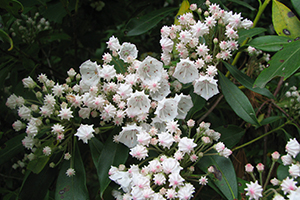Gift adds to Palmer-Adams Preserve Natural Area
Published:
1 year 41 weeks ago Gift adds 31.1 acres to Cornell Botanic Gardens’ Palmer-Adams Preserve in the Town of Caroline, a significant preserve for education, research, and the conservation of rare native plant species
Cornell Botanic Gardens has expanded the Palmer-Adams Preserve and its Bald Hill Natural Area with a gift of 31.1 acres from Arthur H. Adams, ’63, BCV ’65, MEN ’66, and his siblings Andrea A. Hastings, and Drew D. Adams. The tract, located on Bald Hill School Road in the Town of Caroline, will be known as the Palmer-Adams Hilltop Tract, Bald Hill.
The new parcel joins the original 87-acre preserve donated in 1982 by Ithaca lawyer Armand Adams, ’31, and his family. It was named to honor the long involvement of Charles Palmer and Armand Adams in natural history and environmental education. The addition of the hilltop tract brings the total size of the Palmer-Adams Preserve to 118.56 acres.
The hilltop tract is a welcome enhancement to the Palmer-Adams Preserve, whose unique features make it valuable for research and preservation purposes.
 “The Palmer-Adams Preserve—along with a non-contiguous 100-acre parcel and some adjoining state forest land—are the only places in the Cayuga Lake drainage where native mountain laurel, Kalmia latifolia, and hair grass, Deschampsia flexuosa, can be found,” said Todd Bittner, Director of Natural Areas for Cornell Botanic Gardens. “The new tract also improves access for the study and enjoyment of the plants, insects, amphibians, and birds present there. The property is bounded by Bald Hill School Road and offers a new point of entry and trailhead from the east side of the preserve.”
“The Palmer-Adams Preserve—along with a non-contiguous 100-acre parcel and some adjoining state forest land—are the only places in the Cayuga Lake drainage where native mountain laurel, Kalmia latifolia, and hair grass, Deschampsia flexuosa, can be found,” said Todd Bittner, Director of Natural Areas for Cornell Botanic Gardens. “The new tract also improves access for the study and enjoyment of the plants, insects, amphibians, and birds present there. The property is bounded by Bald Hill School Road and offers a new point of entry and trailhead from the east side of the preserve.” A number of researchers from Cornell and other area colleges and universities have utilized the Palmer-Adams Preserve for their work. The preserve has served studies in ecology, evolutionary biology, soil science, insect biology and microbiology.
One ongoing research project in the Palmer-Adams Preserve—along with other Botanic Gardens’ natural areas—is being led by Christine Goodale, professor of Ecology and Evolutionary Biology at Cornell. Goodale has been measuring uptake of carbon dioxide in these forested areas for several years.
“One especially valuable attribute of the parcel is the side-by-side location of primary forest (never cultivated or with some light harvest) and old-field forest, that which has not been cultivated in 100 or more years,” she said. “We see that the old-field forests gain CO2 in both trees and soils for more than a century after abandonment, and that the primary forests are still very productive even though they are relatively old.”
The Cornell Botanic Gardens’ provides public access to the Bald Hill Natural Area and the Palmer-Adams Preserve via a 1.1-mile trail, accessible from either Bald Hill or Bald Hill School Roads in the Town of Caroline. Wooded trails ascend portions of a very large, contiguous forested area along an abandoned road in this southeastern part of Tompkins County.



